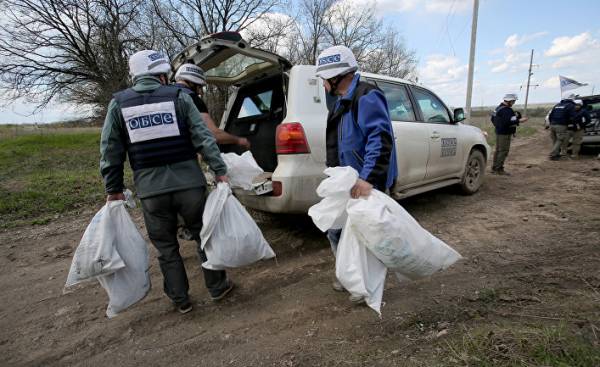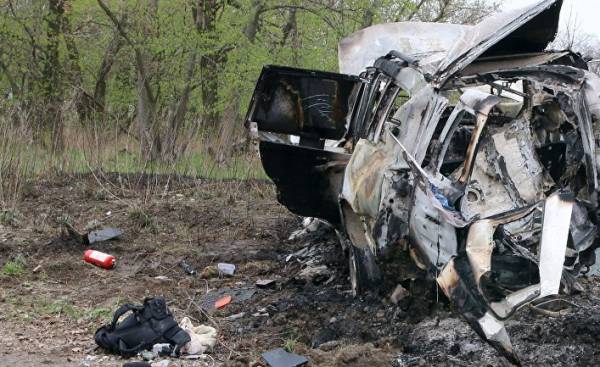
At about half past ten on April 23 of this year, the car owned by the patrol of the OSCE observers, was blown up near the front lines between Ukrainian government forces and Pro-Russian separatists in the Luhansk region.
The explosion killed one American. One Czech and one German were injured. The Norwegian, who was in another patrol car, was not injured from the explosion.
Powerful mine
Patrol out of forward bases of the organization in the city of Stakhanov, which formally regained its old name Kadievka.
Cars driving along a narrow dirt road near the village of Prishib, when the explosion occurred powerful mines.
The area where the driving machine is located near the front line in the Luhansk region in the North Donets river. The Ukrainian authorities are in control of one side of the river Bank and the Pro-Russian separatists or two there and drove this car.
The American Joseph stone (Joseph Stone), the patrol medic, who was sitting in the back seat, was killed, probably instantly.
Not an accident
“We have no doubt that this was not ordinary traffic accident, it was mine, deliberately laid, where the passing cars of the OSCE,” — said Alexander hug (Alexander Hug) in an interview with NRK.
Swiss diplomat 2014 performs the difficult task to lead in Ukraine, by the observer corps, numbering more than 500 men and women.
“But we can’t say that it was mine, pledged to undermine our patrol,” says hug, adding that currently under investigation to clarify the incident.
 © The people’s militia LNR | go to fotoangelo blasting of the car of employees of the patrol of the OSCE mission in Luhansk region
© The people’s militia LNR | go to fotoangelo blasting of the car of employees of the patrol of the OSCE mission in Luhansk region
To this case joined by the American security service, the FBI, as a result of explosion of a powerful land mines killed an American citizen.
It was undermined by anti-tank mine, and according to the information obtained NRK, says a lot about what mine was powered by a remote trigger.
Failure to visit dangerous sites
Neither the Pro-Russian separatists or Ukrainian government forces has claimed responsibility for the attacks. But the consequences of this disruption are great.
Last but not least for tens of thousands of people living almost pyatisotletny front line or the contact line, officially called “border” that comes from the sea of Azov in the South through the Donbas to the border in the North with Russia on the North-East.
“After what happened on April 23, we have introduced a rule according to which our patrols ride only on paved roads and at a certain distance from the contact line,” — said Alexander Hg.
Correspondents NRK met with a Hug at the headquarters of the OSCE in the city of Kramatorsk in the part of Donetsk region, controlled by Ukrainian government forces.
“Therefore, we no longer have the opportunity to help maintain the truce in some areas, to repair the house, restore power lines and water pipelines and to ensure delivery,” says hug, who takes very seriously the situation in the aftermath of the death of one of its employees.
A large number of Norwegians in the conflict areas
“We have reports of hundreds, even thousands of ceasefire violations every day,” says Alexander hug.
He believes that this is only the tip of the iceberg, because they no longer have the opportunity to observe the ceasefire everywhere, and that this in turn increases the desire of the sides to start shooting.
“This, of course, is a threat, primarily, for the civilian population, but also for hundreds of our observers,” says hug.
Norway is thoroughly presented in the most dangerous area of conflict: four Norwegian has lately been placed on an extended basis in Stakhanov.
At the same time, the operation of the OSCE in Lugansk is headed by Lieutenant General Arne Bard Dalhaug (Arne Bård Dalhaug). Therefore, the Norwegian authorities are also involved in the maintenance of security in the Donbass.
The head of the corps of observers Alexander hug after the interview with NRK went to inspect the front line of Donetsk.
According to NRK, the OSCE is currently carefully studying the possibility of implementing the tasks received after the Minsk agreements in February 2015: to observe the ceasefire, which ensures the safety of the civilian population in the area.
Armed peacekeeping in Donbas?
The idea is to send in the Donbass armed peacekeeping force under UN auspices and therefore to handle the situation, and in the future make possible the integration of the areas under the control of separatists in the rest of Ukraine.
But now the entire peace process stopped, and almost every day people are dying.
“The positive point is that civilians every day cross the contact line. We are talking about 15-20 thousand people, and it shows that for most of the civilian population is important to maintain contacts. It is understood by the separatists and the Ukrainian government, so the crossing points remain open. It gives hope that someday the conflict will be resolved,” — said the head of the OSCE mission Alexander hug correspondents NRK.







